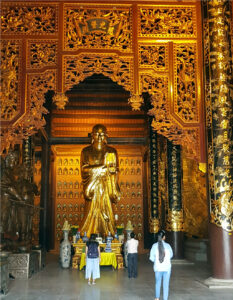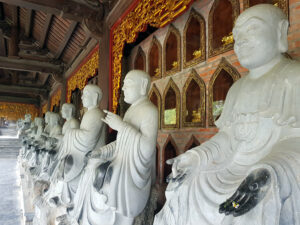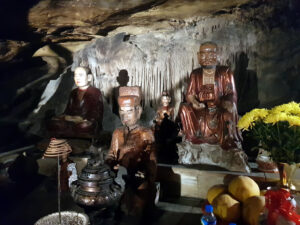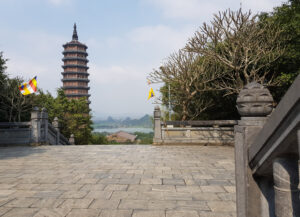The namesake mountain of the Gia Vien district hosts Bái Đính, which means “Towards Mount Đính”. Situated about 5km northwest of the Hoa Lu ancient capital and 12km from Ninh Binh city, this area witnessed many heroic events that shaped Vietnamese history. Nowadays Bai Dinh Pagoda has morphed into a major tourism site of massive pagodas, temples, gardens, statues and stupas.
Legend says that King Dinh Tien Hoang, the First Emperor of the Dinh Dynasty, built a sacrificial altar in a hidden cave here to pray for favorable wind and rain – strategic necessities in the many battles he fought during his lifetime. The altar is supposedly still there but Bai Dinh is no longer a small religious reminder of the beginnings of an Independent Vietnam.
Modern day Bai Dinh is more like a “Pagoda”park” and occupies an area of 1700 hectares. While a respectable 27 hectares remain as part of the “old” Bai Dinh temple, the “new” Bai Dinh Pagoda area exceeds 80 hectares. It truly is a massive construct in any meaning of the word.
Besides their religious importance, traditional Vietnamese Temples and Pagodas are also artistic showcases – in a similar vein to the Great Western Cathedrals like St Paul’s in London and the Sistine Chapel at the Vatican. In architectural splendor, Bai Dinh Pagoda upholds this tradition well. Much of the work was done by sourcing craftsmen from surrounding and distant villages renown for their handiwork. Besides the numerous concrete paths and entry points, there is little else “artificial” about Bai Dinh as its constructs still follows the precepts of traditional Vietnamese religious architecture.
Modern Buddhism at Bái Đính Pagoda
Even at first glance, the buildings at the site are stunning – massive, elegant, and extravagant. Demonstrating the same level of care and consideration as the finest ancient pagodas, craftsmen adorned the walls and gardens with heavy ironwood beams, intricately worked stone and brick masonry, and thoughtful design. Carved white marble Buddhas line the connecting walkways, while exquisitely cultivated gardens feature smaller temples, towers, ancestor houses, statues, and shrines A rudimentary viewing of the site will take at least a couple of hours but plan to spend half a day or more to explore the site’s full extent.
However, Bai Dinh Pagoda is not simply a static display of an ancient culture; it is a vibrant complex that reflects modern Vietnam’s spiritual liveliness, wealth, culture and color. While it may sometimes seem like a spiritual Disneyland, the monks and shrines are genuine and held in high esteem. Bai Dinh serves both traditional and contemporary worshipers, with ancient shrines steeped in history and legends hedged by numerous decks, alcoves, and niches specifically designed for those all important photo opportunities.
The old Bai Dinh temple is located about 800 meters south of the new pagoda area. To reach it, visitors have to climb 300 stone steps that go under the entrance area’s ornamental gate. Unlike the ostentatious splendor of the new pagoda, the old temple is a series of small caves and grottoes, all of which are home to a variety of Buddhist deities, spirits, and shrines, often on natural rock ledges laden with offerings and candles.
Ancient Buddhism
This section of the complex is arguably the holiest and undoubtedly the most ancient of all. Believed to be the place where Dinh Binh Bo Linh himself retreated for blessings and meditation, the center of this area is the Ancestor House, reflecting the more Confucian mores of that period. Ancestor shrines abound, places where offerings such as fruits, sweets, and gifts are made to deceased heroes, friends, family and important figures, often in fidelity but also in the hope of future blessings. These will sometimes include “votive” (hang ma) offerings – paper replicas of motorbikes, cars, houses, and, of course, the famous fake currency of “Hell Bank notes”. After worship, these gifts are burnt to enable them to rise to the heavens for ancestral use.
To juxtapose this, Buddha is worshiped in the “Light cave” on the right side of the Ancestor house, while a small temple dedicated to Cao Son, the god of the western Vu Lam mountains, is located nearby. Cao Son is famous throughout Vietnam in a variety of incarnations in a history dating back to the Van Long/Au Lac dynasties of the Kings (2879 BC – 258 BC).
On the left side of the pagoda, there is a temple honoring Saint Nguyễn aka Nguyễn Minh Không aka Ly Quoc Su. Saint Nguyễn was a skilled Zen Master, magician, metallurgist, poet and healer who is revered as a deity in the Vietnamese pantheon. This towering figure of Vietnamese history has over 26 temples in Ninh Binh itself, with hundreds more scattered through the nation.
Đạo Mẫu
The adjacent winding “Dark” cave is for the women’s folk religion of Đạo Mẫu, celebrating the four goddesses guarding heaven, earth, water and mountains and incorporating many more spirits of the land. The cave is full of various representations of the four (+ 1) goddesses plus the associated religious, ancestral, and mythical accoutrements. Candles decorate the dimly lit grotto, giving the various statues an ethereal appearance that is befitting of a place credited as the birthplace of a nation.
If the old pagoda area is in reverence of things past, the new pagoda is a celebration of the nation that Vietnam has become and aspires to. A rambling, multi-faceted palace reflecting the living soul of Vietnam, it would be impossible to sum up all that Bai Dinh Pagoda offers to the interested visitor in a few short paragraphs. It is a place to enjoy, to contemplate, to pray and maybe take a few selfies while you are at it. Vietnamese spirituality is complicated, if nothing else!
Buddhism Reborn
Take your time when exploring South East Asia’s largest pagoda complex, as it is continuously expanding. The complex comprises numerous structures built in various phases, starting in 2003, with the initial design completed in 2010. More than 500 artists, builders, and craftspeople from traditional villages across the nation were involved in constructing the complex.
Mainly using locally available resources, the Ninh Binh green stone, ironwood and dark brown Bat Trang glazed tiles were purposely selected as to be as close to the original Ancient city materials as possible. The various constructs themselves are dazzling works of art from famous Vietnamese craft villages. Places like Y Yen (bronze work), Ninh Van (stone carving art), Phu Loc (carpentry) and Ninh Hai (embroidery) among many others.
Bai Dinh Pagoda boasts several impressive features including the tallest gold-coated bronze Buddha statue in Asia (Phap Chu Hall), the biggest Great Bell (Bell Tower), the most populous Bodhi forest in Vietnam, the longest corridor of Arhat (“perfected person”) statues in Asia, the largest Ngoc (Pearl) Well in Vietnam, and more. While at times it might seem like a competition, visitors can enjoy the great walks and vistas to contemplate the beauty and majesty of this fertile, ancient land. So take your time and savor all that Bai Dinh Pagoda has to offer.
Festivals
The spring festival takes place in the first month of the lunar year(usually between January and March) and is a highlight of the festival calendar. Exact dates can be difficult to determine in advance due to the difference between the Vietnamese Lunar and the Gregorian Solar cycles. It can get more confusing if dates are randomly interchanged though the confusion often comes from misinterpretation, not malice.
For instance, a given date of February 8 may be literally February 8 or alternatively can refer to the 8th day of the second lunar month (ngày 8 tháng 2). Since almost every spiritual or cultural event in Vietnam is based on the lunar cycle, learn to always double check it.
Ninh Binh literally explodes into life during the spring festival. The cool winter weather gives way to warm sunny days where flowers are rampant, a green carpet of rice coats the fields and the forest teeming with bird and wildlife. People are generally in a happy mood, putting the past bihind and looking forward to, hopefully, a prosperous future.
Remember though, it is also the peak season for domestic tourism. Thousands of visitors attend festivals celebrating the generous history of this remarkable city-state, leading to overcrowding, price hikes, and hotel shortages. But if you truly want to experience the spiritual and social life of North Vietnam, you won’t find a more fitting region If you prefer peace and quiet, this might be the time to get out of town to a more tranquil setting such as the Cuc Phuong National Park.or the Van Long Wetlands. Just bring your mosquito repellent.
Bái Đính Pagoda Travel Tips
Bai Dinh Pagoda is located approximately 5km from Hoa Lu Ancient Capital and 15km from Ninh Binh city. The best transportation options are tour groups taxis, Grab/GoViet, or self-driving on a rented motorcycle. Keep in mind that Bái Đính Pagoda is not close to any major villages and it can be difficult to find a taxi or Grab for the return trip. Try to arrange a return pickup with a taxi; otherwise, you might end up stranded miles from town
The park entrance is free and parking fees range from 40-50000 VND for cars and 15-20000 VND for motorbikes. Since the parking lot is around 4 km from the Tam Quan gate of Bái Đính Pagoda, most visitors choose to take the electric tram service, which costs about 30,000VND each way.Bái Đính Pagoda. The park entrance is free and parking fees range from 40-50000 VND for cars and 15-20000 VND for motorbikes. Since the parking lot is around 4 km from the Tam Quan gate of Bai Dinh Pagoda, most visitors choose to take the electric tram service, which costs about 30,000VND each way.
Tour guide services are available for +/- 300,000 VND in the new temple and +/- 500,000 VND for both the new and old temples. The cost to use the toilet is 2,000 VND per visit, and climbing the iconic Bái Đính Pagoda Tower costs approximately 50,000 VND.
*note: Prices are circa 2023 and a guide only,






